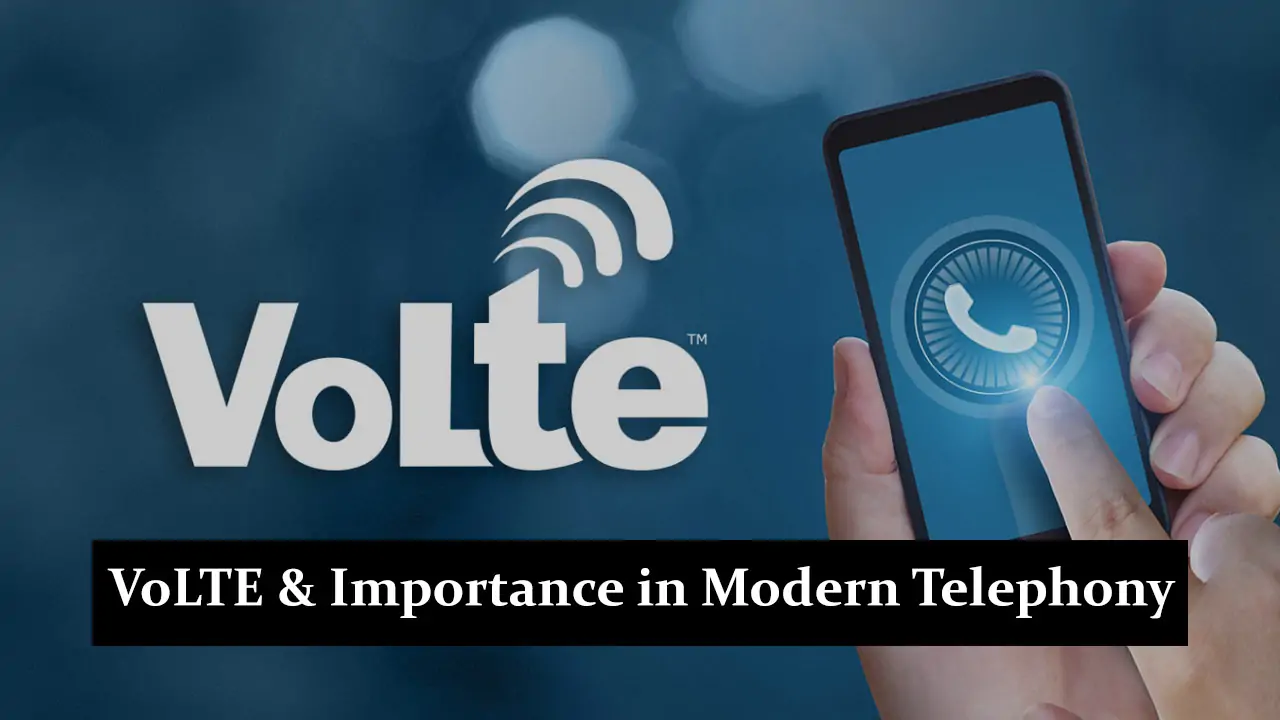Voice over LTE (VoLTE) is a technology that enables high-quality voice calls over 4G LTE networks, enhancing call clarity and reducing latency compared to traditional 2G or 3G networks. VoLTE supports simultaneous voice and data usage, allowing users to browse the internet or use apps on a call. Its importance in modern telephony lies in its ability to provide superior call quality, improve network efficiency, and offer additional features like video calling and faster call setup times. As mobile networks evolve, VoLTE becomes a standard feature, ensuring seamless and efficient communication.
What is VoLTE?
Voice over LTE (VoLTE) is a technology that allows voice calls to be made over a 4G LTE network rather than traditional 2G or 3G networks. This results in higher-quality voice calls, faster call setup times, and the ability to use data services while on a call without degradation. VoLTE leverages the IP Multimedia Subsystem (IMS) to provide these enhanced capabilities, making it a key component in the transition to all-IP networks.
Technology
Unlike traditional voice calls that use circuit-switched networks, VoLTE employs packet-switching technology, which is more efficient and provides better call quality. This technology allows for HD voice, making conversations clearer and more natural.
Key Features:
- High Definition (HD) Voice: Provides clearer and more natural conversations.
- Simultaneous Voice and Data: Enables users to use voice and data services simultaneously without degradation in quality.
- Faster Call Setup: Reduces the time it takes to connect a call.
- Better Battery Life: More efficient use of network resources can lead to improved device battery life.
- Enhanced Coverage and Capacity: Better spectrum efficiency can enhance network coverage and capacity.
History
VoLTE development began in the early 2010s, with MetroPCS’s first commercial deployment in the US in 2012. Since then, it has gained traction worldwide due to its advantages over older technologies.
Key Milestones:
- 2012: MetroPCS launched the first commercial VoLTE service in the US.
- 2014: Major carriers like AT&T and Verizon began deploying VoLTE.
- 2016: VoLTE became more widely available across different regions, including Europe and Asia.
- 2020s: Continued expansion and enhancement of VoLTE services, integrating with 5G networks for even better performance.
How VoLTE Works
Voice over LTE (VoLTE) transmits voice data over the 4G LTE network using IP Multimedia Subsystem (IMS) technology. This advanced system breaks down voice data into packets and sends them over the LTE network, designed primarily for data rather than voice. This method enables higher-quality and more reliable voice communication, offering significant advantages over traditional voice call technologies.
Key Features of VoLTE Technology
- Enhanced Call Quality: VoLTE provides high-definition (HD) voice quality, making conversations clearer and more natural.
- Efficient Network Usage: Using the existing LTE data network, VoLTE makes more efficient use of network resources, reducing the need for separate voice channels.
- Faster Call Setup: VoLTE can significantly reduce call setup times compared to traditional circuit-switched calls.
- Simultaneous Voice and Data: Users can browse the internet and use data services while on VoLTE, which is impossible with older voice call technologies.
Steps in the VoLTE Call Process
- Call Initiation: The user’s device initiates a VoLTE call request to the network.
- IMS Registration: The device registers with the IMS network, ensuring it is authorized to use VoLTE services.
- Session Establishment: The network establishes a session between the calling and receiving devices.
- Voice Data Transmission: Voice data is encoded into packets and transmitted over the LTE network.
- Call Termination: The session is terminated when the call ends, freeing up network resources.
Comparison with Traditional Voice Calls
Traditional voice calls on 2G/3G networks use circuit-switched technology, which is less efficient and offers lower call quality. VoLTE, on the other hand, uses packet-switched technology, providing better call clarity and reliability. This comparison highlights the technological advancements and benefits of VoLTE over traditional voice calls.
Differences Between Circuit-Switched and Packet-Switched Technologies
- Circuit-Switched (2G/3G):
- Dedicated Channel: Establishes a dedicated channel for the duration of the call.
- Lower Efficiency: Less efficient use of network resources.
- Inferior Call Quality: Typically offers lower call quality and clarity.
- Separate Data and Voice Channels: Requires separate channels for voice and data, preventing simultaneous use.
- Packet-Switched (VoLTE):
- Data Packets: Transmits voice data in packets over the LTE network.
- Higher Efficiency: More efficient use of network resources.
- Superior Call Quality: Provides high-definition voice quality.
- Unified Channel: Uses the same channel for both voice and data, allowing simultaneous usage.
Steps in the Traditional Voice Call Process
- Call Setup: The device initiates a call request, and the network allocates a dedicated channel.
- Channel Establishment: A circuit-switched channel is established between the calling and receiving devices.
- Voice Transmission: Voice data is transmitted over the dedicated channel.
- Call Termination: The channel is released when the call ends, making it available for other calls.
Benefits of VoLTE
- Improved Call Quality: VoLTE supports HD voice, offering significantly better call quality than 2G and 3G networks. The higher bandwidth of LTE networks allows for clearer and crisper audio.
- Simultaneous Data and Voice: Unlike traditional networks, where using data while on a call can be challenging, VoLTE allows for simultaneous voice and data usage. This means you can browse the internet or use data-heavy apps without interrupting your call.
- Battery Efficiency: VoLTE can improve battery life by using a more efficient LTE network for voice calls, reducing the need for your device to switch between different types of networks.
- Reduced Latency: VoLTE calls have lower latency than traditional voice calls, meaning there is less delay between when you speak and when the other person hears you, leading to more natural conversations.
VoLTE and Network Efficiency
Network Utilization:
VoLTE optimizes network resources by using the same network for both voice and data, reducing the strain on older types of networks and improving overall network efficiency. This technology ensures seamless integration and utilization of the existing LTE network infrastructure, making it a pivotal advancement in mobile communication.
Key Benefits of Network Utilization with VoLTE:
- Seamless Integration: VoLTE uses the LTE network for voice and data services, ensuring smoother transitions and improved service quality.
- Reduced Strain on Older Networks: By utilizing the same network for voice and data, VoLTE minimizes the burden on legacy networks like 2G and 3G.
- Improved Call Quality: VoLTE provides high-definition (HD) voice quality, significantly enhancing the user experience.
- Simultaneous Voice and Data: Users can browse the internet, download apps, and make voice calls simultaneously without interruption.
- Enhanced Connectivity: VoLTE ensures better connectivity in areas with weak signals, providing more reliable service.
Spectrum Efficiency:
VoLTE offers carriers better spectrum efficiency, allowing them to use their available spectrum more effectively and deliver higher-quality services to more users. This efficiency is crucial for managing the ever-growing demand for mobile data and ensuring optimal use of limited frequency bands.
Advantages of Spectrum Efficiency with VoLTE:
- Higher Data Throughput: VoLTE provides better data throughput, allowing carriers to offer faster internet speeds to users.
- More Users on the Network: Improved spectrum efficiency enables carriers to accommodate more users simultaneously without degrading service quality.
- Enhanced Service Quality: VoLTE ensures that voice calls and data services are delivered with higher quality and reliability.
- Cost-Effective: Carriers can maximize their existing spectrum, reducing the need for additional spectrum purchases and infrastructure investments.
- Future-Proofing: VoLTE prepares carriers for future advancements in mobile technology, ensuring long-term viability and competitiveness.
VoLTE Adoption and Compatibility
Global Adoption
VoLTE adoption is growing rapidly worldwide. Major markets such as North America, Europe, and Asia have seen significant uptake, with many carriers offering VoLTE as a standard feature.
Key Factors Driving Global Adoption:
- Increased Network Efficiency:
- VoLTE provides more efficient use of network resources compared to traditional voice services.
- It allows carriers to free up spectrum previously used for 2G and 3G networks.
- Enhanced Call Quality:
- VoLTE offers superior call quality with HD voice capabilities.
- It reduces background noise and provides clearer voice transmission.
- Improved Connectivity:
- VoLTE enables faster call setup times compared to 2G and 3G.
- It supports simultaneous voice and data usage.
Device Compatibility:
Most modern smartphones support VoLTE. Users can check their device settings or contact their carrier to confirm if their device is VoLTE-compatible.
Steps to Check Device Compatibility:
- Check Device Settings:
- Go to the settings menu on your smartphone.
- Look for the “Cellular” or “Mobile Network” section.
- Check for a “VoLTE” option and ensure it is enabled.
- Consult the Manufacturer’s Website:
- Visit the official website of your smartphone’s manufacturer.
- Search for your specific device model.
- Look for information on network compatibility and VoLTE support.
- Contact Your Carrier:
- Reach out to your carrier’s customer service.
- Provide your device model and ask if it supports VoLTE.
- Follow any additional steps they provide to enable VoLTE on your device.
Carrier Support:
While most major carriers support VoLTE, the extent of coverage and support can vary. Users should verify with their carriers about the availability of VoLTE in their area.
Steps to Verify Carrier Support:
- Visit Carrier’s Website:
- Go to the official website of your mobile carrier.
- Look for information on VoLTE services and coverage maps.
- Check if VoLTE covers your area.
- Contact Customer Support:
- Call or chat with your carrier’s customer service.
- Ask about the availability of VoLTE in your location.
- Inquire about any additional settings or steps needed to enable VoLTE.
- Read User Reviews and Forums:
- Look for reviews and discussions online about VoLTE experiences with your carrier.
- Join community forums or social media groups related to your career.
- Gain insights from other users about VoLTE performance and coverage.
Challenges and Limitations
Coverage Issues
While VoLTE (Voice over LTE) coverage is expanding, there are still areas, especially in rural or remote locations, where VoLTE might not be available. This can lead to connectivity challenges and limit the benefits of VoLTE in these areas.
Impact on Users
- Limited access to high-quality voice calls
- Potential reliance on older, less reliable networks
- Inconsistent user experience in different locations
Addressing Coverage Issues
- Invest in network infrastructure in underserved areas
- Collaborate with local governments to enhance coverage
- Educate users about coverage limitations and alternatives
Interoperability
Interoperability between different carriers can sometimes be an issue, leading to potential call drops or quality issues when making calls between networks. This can affect the reliability and user experience of VoLTE services.
Causes of Interoperability Issues
- Differences in network technology and standards
- Inconsistent implementation of VoLTE protocols
- Lack of coordination between carriers
Steps to Improve Interoperability
- Standardize VoLTE protocols across carriers
- Conduct regular interoperability testing
- Establish agreements between carriers for seamless connectivity
Emergency Calls
Handling emergency calls over VoLTE can be challenging, as the technology is evolving to ensure reliable connections during emergencies. Ensuring emergency services can be reached without issues is crucial for public safety.
Challenges in Emergency Calls over VoLTE
- Ensuring network reliability during high-traffic periods
- Providing accurate location information to emergency responders
- Ensuring backward compatibility with older networks
Improving Emergency Call Handling
- Enhance network capacity and reliability
- Implement advanced location-tracking technologies
- Collaborate with emergency services to test and refine VoLTE systems
Conclusion
VoLTE (Voice over LTE) represents a significant advancement in telecommunication technology, providing superior call quality, the ability to use voice and data simultaneously, enhanced battery efficiency, and reduced call latency. We explored VoLTE’s underlying technology, its development history, and how it compares to traditional voice calls. We discussed the benefits, network efficiency, adoption rates, device compatibility, and challenges associated with VoLTE.









